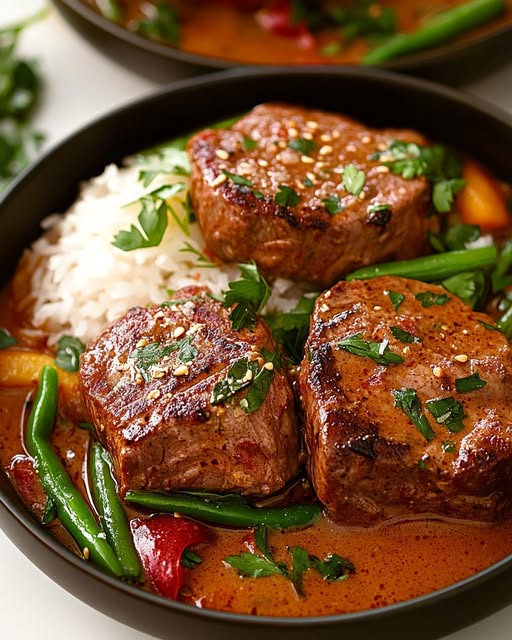Why Gordon Ramsay’s Filet Mignon Will Change Your Dinner Game
Picture this: a perfectly cooked filet mignon, tender and juicy, with a golden crust that crackles as you slice into it. Sounds like something you’d only get at a fancy restaurant, right? Wrong! I tried Gordon Ramsay’s Perfect Filet Mignon recipe one Friday night, expecting disaster but ending up with pure magic. It’s surprisingly simple to make, even for someone like me who once burned water (true story). Whether you’re cooking for a special occasion or just want to treat yourself, this recipe will have your taste buds dancing.
A Little Backstory About Filet Mignon
Filet mignon is often called the “king of steaks” because it comes from the tenderest part of the cow—the short loin. The name itself means “cute little filet” in French, which makes sense since it’s small but mighty. Historically, filet mignon was reserved for royalty and high society, but today it’s become a staple on fine dining menus worldwide. When I first heard about Gordon Ramsay’s take on it, I thought, “How hard can it be?” Turns out, not hard at all if you follow his method!
Why You’ll Love This Recipe
This recipe is perfect for anyone who wants restaurant-quality food without leaving their kitchen. The flavors are bold yet balanced, thanks to the simple seasoning of salt, pepper, and olive oil. Plus, the technique—searing followed by oven finishing—is foolproof. Even my picky nephew, who claims vegetables are “not his thing,” couldn’t stop raving about how amazing this dish tasted. Trust me; you won’t regret giving this a try.
Perfect Occasions to Prepare This Dish
Looking to impress your date? Hosting a holiday dinner? Or maybe you just feel like treating yourself after a long week? This Perfect Filet Mignon fits every scenario. It’s elegant enough for Valentine’s Day or anniversaries but easy enough for a cozy Sunday supper. My favorite memory was serving it during a surprise birthday party for my best friend. Everyone kept asking, “Did you really make this?” Yes, yes I did.
Ingredients
- 170g of filet mignon
- 2 tablespoons of olive oil
- 1 tablespoon of kosher salt
- 1 tablespoon of freshly ground black pepper
Substitution Options
If you don’t have kosher salt, regular sea salt works too. For those avoiding heavy oils, avocado oil is a great alternative to olive oil. And while fresh ground pepper adds extra punch, pre-ground pepper will still do the trick if you’re in a pinch.
Preparation Section
Step 1: Preheat Your Oven
Start by preheating your oven to 200°C (400°F). While it heats up, grab your filet mignon and give it a quick pat dry with paper towels. Removing excess moisture helps create that dreamy sear later. Next, drizzle a bit of olive oil over both sides of the steak and rub it in gently. Sprinkle generously with kosher salt and freshly ground black pepper. You want the seasoning to stick nicely, so press it lightly onto the surface. Pro tip: Let the steak sit at room temperature for about 10 minutes before cooking—it cooks more evenly this way.
Step 2: Heat Up the Pan
Place your skillet in the preheated oven for a few minutes until it gets piping hot. A super-hot pan ensures a gorgeous caramelized crust on the outside of the steak. Once heated, carefully remove the pan using oven mitts (safety first!) and set it on the stovetop over medium-high heat. If you don’t have an oven-safe skillet, no worries—you can transfer the steak to a baking sheet after searing.
Step 3: Sear the Steak
Add the seasoned filet mignon to the hot pan and let it sizzle away undisturbed for 2½ minutes per side. Listen to that satisfying sizzle—it’s music to any cook’s ears. Don’t move the steak around; letting it sit creates a beautiful golden-brown crust. Keep an eye on it, though, because timing matters here. Chef’s tip: Use tongs instead of a fork to flip the steak. Piercing it with a fork lets juices escape, and we definitely don’t want that.
Step 4: Finish in the Oven
After searing, pop the skillet back into the oven for about 5 minutes. This step ensures the inside of the steak reaches your desired doneness. Grab your trusty meat thermometer and check the internal temperature. Aim for 52°C (125°F) for a perfect medium-rare. Remember, the steak will continue to cook slightly as it rests, so pull it out just before it hits your target temp.
Step 5: Rest and Serve
Once done, place the steak on a cutting board and cover it loosely with foil. Let it rest for 5 minutes—this allows the juices to redistribute throughout the meat. Slice against the grain, plate it up, and serve it hot. Pair it with mashed potatoes or roasted veggies for a complete meal. Yum!
Timing
Here’s a quick breakdown of the timings:
- Prep time: 10 minutes
- Cooking time: 10 minutes
- Resting time: 5 minutes
- Total time: 25 minutes
Chef’s Secret
Want to take your Perfect Filet Mignon to the next level? Add a dollop of compound butter on top right after resting. Mix softened butter with minced garlic, parsley, and a squeeze of lemon juice—it melts beautifully over the steak and adds incredible flavor.
Extra Info
Did you know that filet mignon contains less fat than other cuts of beef? That’s why it’s so tender, but also why proper seasoning is key. Without much marbling, the steak relies on external flavors to shine.
Necessary Equipment
To nail this recipe, you’ll need a few essentials:
- An oven-safe skillet
- A meat thermometer
- Tongs
- Oven mitts
Storage
If you happen to have leftovers (good luck with that!), store them properly to keep the quality intact. Wrap the steak tightly in plastic wrap or aluminum foil and refrigerate within two hours of cooking. It should stay fresh for up to three days.
For longer storage, freeze the steak in an airtight container or freezer bag. Label it with the date so you remember when it was made. Frozen filet mignon keeps well for up to three months.
When reheating, avoid microwaving, as it can dry out the meat. Instead, warm it gently in the oven at 150°C (300°F) until heated through. Cover it with foil to retain moisture.
Tips and Advice
Always bring your steak to room temperature before cooking—it ensures even cooking. Also, resist the urge to overcrowd the pan. Cook one steak at a time if needed, giving each piece the attention it deserves. Lastly, sharpen your knives before slicing. A clean cut makes all the difference.
Presentation Tips
Garnish with a sprig of fresh rosemary or thyme for a pop of color. Drizzle a bit of balsamic glaze around the plate for elegance. Serve on warm plates to enhance the dining experience.
Healthier Alternative Recipes
Love filet mignon but looking for lighter options? Here are six ideas:
- Grilled Filet Mignon: Skip the oven and grill the steak for a smoky twist.
- Air Fryer Version: Achieve crispy edges with less oil.
- Herb-Crusted Steak: Coat the filet with crushed nuts and herbs for added texture.
- Sous Vide Style: Cook sous vide for precise control over doneness.
- Vegan Mushroom “Steak”: Swap the beef for portobello mushrooms marinated in soy sauce and spices.
- Low-Sodium Option: Reduce the salt and use smoked paprika for depth.
Common Mistakes to Avoid
Mistake 1: Overcooking the Steak
Overcooked filet mignon turns tough and chewy, ruining its delicate texture. To avoid this, always use a meat thermometer to monitor the internal temperature. Pull the steak off the heat just before it reaches your ideal doneness, as carryover cooking will finish the job.
Mistake 2: Skipping the Rest
Not letting the steak rest leads to uneven slices and lost juices. Patience pays off here—those five minutes make a world of difference.
Mistake 3: Using a Cold Pan
A cold pan won’t give you that sought-after crust. Always preheat your skillet thoroughly before adding the steak.
FAQ
What is filet mignon?
Filet mignon is a premium cut of beef taken from the smaller end of the tenderloin. Known for its tenderness and mild flavor, it’s a favorite among steak lovers.
How do I know when my steak is done?
Use a meat thermometer to check the internal temperature. For medium-rare, aim for 52°C (125°F).
Can I use a regular skillet?
Yes, but you’ll need to transfer the steak to a baking sheet after searing.
Should I marinate filet mignon?
It’s not necessary, as the tender cut doesn’t require tenderizing. However, a quick marinade can enhance flavor.
What pairs well with filet mignon?
Classic sides include mashed potatoes, green beans, and a red wine reduction sauce.
Is filet mignon healthy?
While rich in protein, it’s also higher in calories. Balance it with lighter sides for a nutritious meal.
How do I store leftovers?
Wrap tightly in plastic wrap and refrigerate for up to three days.
Can I freeze filet mignon?
Yes, freeze in an airtight container for up to three months.
Why is my steak tough?
It might be overcooked or sliced incorrectly. Always cut against the grain for maximum tenderness.
Do I need expensive equipment?
No, basic tools like a skillet, tongs, and thermometer are sufficient.
A Final Word
Gordon Ramsay’s Perfect Filet Mignon is proof that gourmet meals don’t have to be complicated. With a few simple steps, you can create a dish that feels luxurious yet approachable. So go ahead, fire up the stove, and treat yourself to something truly special. Bon appétit!

Perfect Filet Mignon
Ingredients
Equipment
Method
- Preheat your oven to 200°C (400°F) and pat the filet mignon dry with paper towels.
- Drizzle olive oil over both sides of the steak, and season with kosher salt and freshly ground black pepper.
- Let the steak sit at room temperature for about 10 minutes.
- Heat the oven-safe skillet in the oven for a few minutes until piping hot, then remove it carefully.
- Sear the steak in the skillet for 2½ minutes on each side without moving it.
- Transfer the skillet to the oven and cook for about 5 minutes until the internal temperature reaches 52°C (125°F) for medium-rare.
- Let the steak rest for 5 minutes under loosely covered foil before slicing against the grain.
